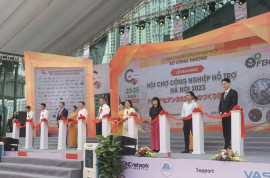Improving production costs is becoming an increasingly important issue in the global manufacturing supply chain in the context of increasing competition and increasing fragmentation in the value chain of the supply chain - there , production is always at the bottom of the value chart.
While global corporations already have mature systems and strong capabilities to effectively pursue strategies to improve production costs, many Vietnamese manufacturing enterprises are still relatively new. and cannot be effectively implemented in this area.
The article "10 principles for improving production cost" shares the research results and experiences of P&Q Solutions in the process of consulting, training and leading improvement, Lean transformation and capacity development programs. competition of manufacturing enterprises.
1) Strategy – Perseverance – Consistency
In the field of production, especially the supporting industry, leaders do not have much "playing ground" related to planning "special" strategies for development. As the aspects of Quality, Delivery, Social Responsibility & Sustainability have become factors to be adhered to, the attractiveness and differentiation is greatly determined by the cost of production. In most manufacturing sectors, the ratio of 95% cost and 5% profit has become common and according to the Pareto principle, the ability to improve the production cost by 95% will be decisive for competitiveness. competition of enterprises, especially in export.
Thus, Improving production costs (Costdown) must be a clear long-term Strategy, pursued persistently and consistently. This is not a temporary solution to cope with difficult times, declining orders - rapid increase in input prices - high interest rates - limiting credit access as many businesses still do. As an evaluation indicator, an enterprise with strong and effective cost improvement programs even in favorable business conditions and development will be an enterprise with high capacity and adaptability to develop.
Through pursuing a Costdown strategy, businesses not only become more competitive in terms of production costs, but also create great opportunities to develop capabilities and build a strong culture of the organization to stay strong. move forward.
2) Maximize Value & Minimize Waste
Production cost improvement is not a “Cost Cut” program because cost-cutting programs, triggered by tough situations, often fail to achieve long-term effectiveness and leave many traces.” scar” in quality to customers, management system and corporate culture.
When looking at the production process of the enterprise from the "value" ordered by the customer, only about 10% - 15% of the activities are actually adding value, which means transforming the product according to the standards of the company. client. About more than 85% of the remaining activities are not value-creating, which can be considered necessary or wasteful activities. Specifically, the conversion rate from raw materials to finished products in some industries can be as low as 70% - 80%; Labor time efficiency can be as low as 50% - 60%, equipment efficiency can be as low as 60%, and capital efficiency can be as low as 50%.
Thus, a good production cost improvement strategy should be based on the analysis of the production cost structure and the current status of operational performance to separate value-added and non-value-added activities. according to customer requirements, thereby finding ways to minimize non-value-added activities while improving and enhancing the value brought to customers.
3) Based on Value Flow & Product Lifecycle
Financial flow is a reflection of the actual value flow of production. Thus, financial flows and performance depend on and should be viewed in close relation to the flow and performance of value flows. Specifically, in the value stream key factors such as production stage, production lead time, quality direct ratio, efficiency ratio using raw materials, equipment and labor are directly related. Next comes the "transactions" of production accounting, the capital cycle - capital costs, cost norms for materials, equipment and labor. Therefore, the program to improve production costs associated with value flows helps businesses understand and have a thorough understanding of the "source" of losses and inefficiencies.
The process of management and production cost in the enterprise starts from the time of making quotation and ends at the end of the product life cycle, including components for services. This process has a clear impact on two critical aspects of business, the ability to receive orders and the efficiency of order fulfillment. In the first aspect, the "target price" pricing model requires enterprises to deeply understand their production cycle with forecast conditions on the basis of multi-organizational participation. ability to develop efficient and flexible production methods that can adapt to changes in order to maintain a competitive advantage over the long term. Throughout the product life cycle, businesses need to continuously monitor and control at all functions and stages the actual movements of production costs compared to the established "target prices" to ensure recognition and Implement every opportunity to resolve issues and improve financial performance. In this process, factors such as the maturity of the production process, the proficiency of the personnel, the depreciation of the equipment, the life of the jig, the size of the raw material order, production and delivery products, should be planned and controlled in order to anticipate and prevent negative impacts on the cost and financial performance of the product.
4) Participating Cross-Function & Cross-Functional Deployment
The structure of production cost includes 5 basic components, in which the cost of reprocessing includes the cost of labor time and the cost of equipment time. These components relate to, and are the result of, the operational planning and implementation of different functions within the enterprise, either independently or in a cross-functional arrangement. Therefore, any effective cost improvement program in a manufacturing enterprise requires the full and active participation of all functions, such as Sales, Shipping, Purchasing, Engineering Engineering, Equipment, Production, Quality, Planning, Personnel, Finance. Based on the functional structure of each business, relevant departments are assigned the responsibility of leading efforts to improve production costs in each specific area.
In the pull-to-order and pull-to-order production model of current supply chains, production costs are fundamentally shaped by four main planning areas: infrastructure planning, production design, and production planning. supply chain and budgeting and realizing through operations. The common mechanism being used in planning these areas is cross-functional – with simultaneous involvement of many departments – to ensure that aspects are considered comprehensively and systematically. Similarly, production management is also based on the principle of cross-functionality, in real time to ensure that fluctuations and arising are recognized in time, comprehensively reviewed and effectively responded. With those characteristics, production cost improvement programs not only need the participation (whoever he wants to do) of all departments, but also need the simultaneous, cross-functional coordination between these parts to ensure the spirit of Nemawashi (a thorough and comprehensive review to solve the root cause).
5) Systematic deployment at all levels in the enterprise
When considering the improvement of production costs as a strategic, participatory cross-functional approach and cross-functional implementation from planning to operating, businesses need a systematic approach. Typical elements of an effective system range from strategy to process and results measurement, from structure to accountability, competence and recognition-motivation. Such a comprehensive system enables cost improvement activities to be integrated as part of the management system, and thus maintained, improved and able to adapt to changes from inside and outside the organization.
An effective cost improvement program with the participation of all levels of the organization also needs to reflect the decentralization of leadership and improvement roles pursued by the organization. A common hierarchical model in manufacturing enterprises divides the participating personnel into 4 levels: Senior Leader, Middle Manager, Field Manager and Production Team Member. In this model, the assignment of roles in cost improvement might include:
- Production team members are mainly involved in maintaining standards and setting production costs, participating in improvement proposals or improvement groups according to the QCC model.
- Site Managers have a key role to play in improving production costs at the stages and factors of production and participation, in addition to ensuring standards and norms are maintained.
- Mid-level management, in turn, leads cost-of-production efforts at the value stream and product lifecycle levels—efforts that often involve multiple functions. In addition, middle management participates in the process of maintaining standards and norms through implementing the “Standard Work of Management”, and proposes – participates in breakthrough improvement programs. products, technology or supply chains.
- Senior leadership leads the overall program in terms of strategy, providing the necessary resources and environment. Senior leaders will also be directly involved in breakthrough production cost improvement initiatives in terms of product, technology or supply chain.
(To be continued)
Author: Pham Minh Thang, Director of P&Q Solutions

















